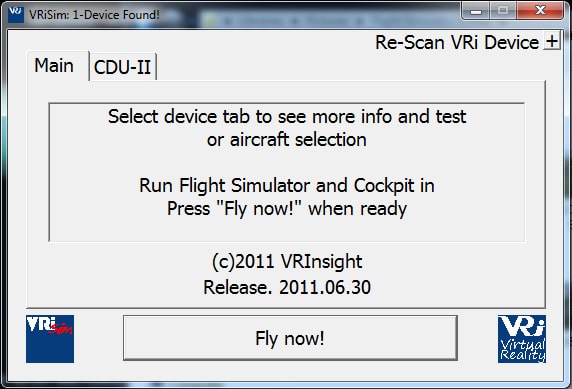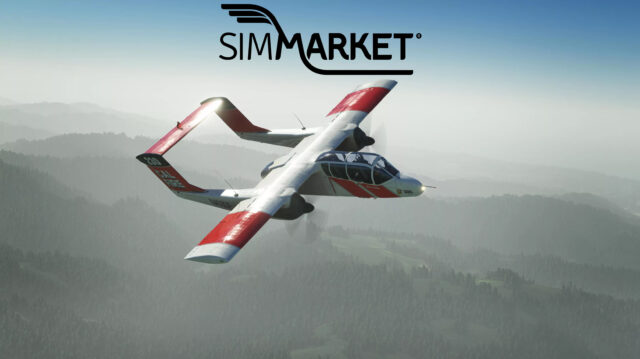If you’re into modern airliners, especially those with a lot of ‘glass’ displays, you’ve probably spent some time thinking about how typing in the CDU (Boeing) or MCDU (Airbus) should be easier than using the mouse. The good news is there are several easier, more realistic and better looking hardware solutions. The downside is they’re quite expensive. We’ll be taking a look at one of them: the Virtual Reality insight (VRinsight or VRi for short) CDU II panel.
Introduction:
The VRinsight CDU II panel is a hardware panel that can mimic the CDU panel of most commercial airliners. It works with both Microsoft Flight Simulator 2004 (FS9) and Microsoft Flight Simulator X. the list of supported add-ons includes popular titles from PMDG, Level-D, Captain Sim and Wilco. In addition to those, the CDU II can be used to display the GPS in any FSX default aircraft.
| Captain Sim B757/767 (FSX) | PSS Airbus Pro/330/340 (FS9) |
| DA Fokker-100 (FSX) | Wilco Airbus Vol1 (FS9) |
| DA Fokker-70 (FSX) | Wilco Airbus Vol1 (FSX) |
| iFly B737NG (FS9) | Wilco Airbus Vol2 (FS9) |
| iFly B737NGX (FSX) | Wilco Airbus Vol2 (FSX) |
| Level-D Boeing 767-300ER (FS9) | Wilco Boeing 737 PIC (FS9) |
| Level-D Boeing 767-300ER (FSX) | Wilco Boeing 737 PIC (FSX) |
| PMDG Boeing 737NG (FS9) | Wilco Boeing 777ER (FS9) |
| PMDG Boeing 737NGX (FSX) | Wilco Bombardier CRJ (FS9) |
| PMDG Boeing 747-400 (FS9) | Wilco Bombardier CRJ (FSX) |
| PMDG Boeing 747-400 (FSX) | Wilco Embraer ERJ (FS9) |
| PMDG MD-11 (FSX) | Wilco Embraer ERJ (FSX) |
Unpacking:
Shipped from SimWare Simulations in Brussels, the CDU II panel I received for testing came well packed. The actual CDU II box was packed in another, larger box, stuffed with packing material to protect the unit from the rigors of transport. The smaller box contains the actual CDU II wrapped in a foam sheet, a driver CD, a sheet with labels for the buttons, cables to connect the unit to your pc, and a bunch of clear covers for the buttons (with several to spare, should you damage or lose some). Additionally, there’s also a VGA-to-DVI adapter included, in case your graphics card uses that connection. What I am missing in the box is a ‘Quick Start Guide’. While it’s not strictly needed, it would be nice to have a small printed manual to guide you through the first steps of setting up, along with a ‘contents’ page, so you can check everything’s there.
Installation and documentation:
The CDU II needs 3 connections to work: a DC power connection, a USB connection to you pc for the keys, and a VGA or DVI connection to your graphics card, to run the display. So the first step is plugging these in. Of course, the DC-adapter goes into a power socket. I got the right adapter here, a 230V-one with a European style plug. I don’t know whether units shipped to other regions come with the relevant adapter as well. As for the display connection, you need a free DVI or VGA connection on your graphics card. Plugging it in on a Matrox TripleHead2Go adapter is not supported.

Once the hardware is connected, it’s time to go over the software. Now, in the box is a CD with drivers and software, along with a manual. But there is newer software to be found on the website, along with a new manual. And it’s not just a new version of the same software, it’s a new program altogether. Oh, and there’s a third version, a beta of a newer version found on the forum. While this is beta software, it’s needed for use with the PMDG NGX.
I would recommend using the beta software, and just keeping clear of the CD or website drivers. The reason for this is twofold: you have the latest version along with the latest compatibility updates, and the download for the beta software has it all in one download.
In the end, there are 2 software packages you need: first of all, the drivers to make the CDU II work on your system. Second, you need the VRiSim software, which is a small program that acts as an interface between FSX and the CDU II. Finally, you’ll also need FSUIPC, although the free version will do, you don’t need the registered version.
After having found the right software, there is something else: the manuals. The included manuals (both old and new) are not very good. The English in which they are written, while understandable, is not very good. But the bigger problem is that, while all needed information is included, the style of writing, layout and general approach of the manuals makes them not very user-friendly in my eyes.
Setting the CDU II up for the first time takes some time. First, you have to setup the display of the CDU II. It’s just matter of using some Windows and Nvidia or ATI settings as described in the manual, so the picture is painted like it should on the display of the CDU II. Then you have to decide what aircraft you want to use it with. For me, I used it with the PMDG NGX. This choice is important because you have to recreate the correct key-layout on the CDU II (which isn’t difficult but it is tedious and time consuming), and you have to configure the aircraft in FS9 or FSX. No manual editing needed here though, a small program called ‘Panel Installer’ is included. What this does is change the 2D popup for the CDU to the name and dimensions required for the CDU II in the relevant aircraft. This has one small downside: this 2D popup becomes unusable (or just about anyway) without the CDU II. But since you have the CDU II anyway, and a backup of the old files is kept, this is not a huge problem. The final part in installing is getting FS to run, select the aircraft, and setup the VRiSim software to use the correct add-on. A note here before I forget: FS has to be running windowed, not full screen. Otherwise it won’t work. A workaround for using it full screen in FSX is available on the VRi forum, but is not officially supported.

Hardware:
The actual CDU II case is built out of metal, making it sturdy, and it looks good as an added bonus. It measures 14cm (L) x 20.5cm (W) x 10cm (H) (or 5.5″ x 8″ x 4″). Included is a 4.8″ LCD display. The CDU II is not heavy, and rests on 4 rubber pads that keep it from sliding around.
The CDU II panel is not a picture-perfect replica of any real life CDU, but it does get the overall layout right: 12 buttons in the numerical section, 30 in the alphanumerical section, 16 function keys (1 more than the real thing, located where real units have a brightness knob) and 12 line select keys. When you get the unit, the keys are all blank. With the included covers and labels you can recreate just about any CDU using this basic layout (Airbus, Boeing, Fokker, McDonnel-Douglas…).
Where the CDU II differs significantly from the real-life examples is that it lacks any lights, either in the ‘exec’ key or next to the keypad. While this reduces realism, it does keep the price down, and once you’re used to the ‘exec’ key not illuminating as usual, I don’t think it’s a deal breaker.

Practical use:
Setting up the CDU II for a flight is a multiple step process. Assuming the display is working (I turn it off in Windows when I’m not flying), you have to start FS, then start your flight, open the 2D CDU panel and undock it. Then you have to start VRiSim, select the aircraft you’re going to fly, and click ‘Fly-now’. This moves the 2D CDU popup to a predetermined position which you can change and save with a small popup from the VRiSim software. Once you’re pleased with it, you click ‘Done’. Now you’re ready to go. Once you get used to that, it goes quickly, but it still is quite a process you have to go through every time you want to use the CDU II.

Now, we can finally start using this piece of hardware! I’ve set the unit I used for this review up as a 737, and used it with the PMDG NGX. It works very well. Using the CDU II for setting up the FMC and typing your flightplan is a lot easier, faster and more fun than using a 2D panel along with the mouse. The only remark I have here is that the CDU II sometimes sends double inputs to the pc upon pushing a button only once. Sometimes annoying, but nothing terrible.
I truly like using the VRinsight CDU II. It makes working with the CDU a lot easier as already said, but it also gives you more overview. You don’t have to open a 2D panel or move your viewpoint in FS9 or FSX to get a quick look at the CDU, you can just do that by taking a real-life look. Very, very nice! Similarly, adjusting your flightplan in the FMC, or setting up holds etc, can be done a lot faster. And more importantly, it’s easier to do it while you’re flying manually compared to using 2D panels or the 3D VC, as there’s no need to change your FS viewpoint, or open panels that block part of your screen. To get an idea, look at the promotion video below this review.
So, using the VRi CDU II is a lot of fun. But there’s one more downside I feel the need to emphasize on: performance. The CDU II is, in fact, a second screen to be powered by the same pc. So even with the strongest pc out there, you will notice a drop in frame rates when you use it. Nothing you can do about it really: driving 2 screens takes more power than driving 1. (or 3 vs 2 etc…) The possible solutions here are learning to live with it if your pc is powerful enough, reducing your FS settings, or buying a faster pc. That last option might be a bit extreme, but it’s an option nonetheless.
A second hit on performance comes from an intermittent problem with the VRiSim software. Sometimes and on some systems, the VRiSim software constantly takes 25% of your CPU power. This is a big hit, which you will definitely notice in performance in FS. I’ve contacted VRi about this, and posted on their forum. This problem has been reported before, but as of yet cause or solution has been offered as far as I know. However, I’ve experienced this problem only intermittently. It doesn’t happen every flight (about 1 in 4 so far). And luckily, most people never experience it at all.

Conclusion:
The VRinsight CDU II panel is a very nice piece of hardware. The concept is great, and the way they realized it in the hardware department is terrific. No, you don’t get a picture perfect replica, but it’s more than good enough. And in return for that little reduction in visual accuracy, you get more adaptability and a lower price. It’s not specifically geared towards the A320, or the 737, or MD-11 or any other aircraft. Instead, you can use it with any of them.
Further, the built-quality of the actual hardware unit seems very good. No, I don’t think it’ll survive a 3ft drop, but being built out of metal, it’s sturdy, and it looks very professional.
The software that comes with it, when you find the right version, also works well. Despite the intermittent CPU load issue some people experience, the software is easy to use and has a very light footprint. The downside is that setting up the CDU II can be a handful.
This brings me to the manual again. While not unusable, with such an expensive piece of hardware, I just want a decent (read: better than the one available) manual, and preferably a short, printed, ‘quick start guide’ in the box as well. As it is, you’ll have to make do with the manual on the website.
And now there’s only one more thing to talk about: the price. The price, in effect, is both high and low at the same time. On simMarket, the CDU II retails for €420 (€342 without VAT). This is a lot of money. But if you compare it to other CDU’s for flightsim, it comes out as the cheapest by a large margin. The reason for this is the aforementioned lack of 100% accuracy, as well as the simplification (no built-in lights, for example).

So, final conclusion: the VRinsight CDU II is an expensive piece of hardware, but comes out as the cheapest in that category of hardware products. Having said that, it’s a lot of fun to use and really adds hugely to the immersion of flightsim. Taking that all into account, I think the CDU II is very good value for money. I really enjoyed testing this product, and I don’t like sending this review unit back, but it’s (for me personally) too expensive to buy myself. However, if I had €420 lying around with which I really didn’t know what to do, this would certainly be high on my wish list.
Like:
- A lot of fun to use, easier and more immersive than 2D panels or 3D VC buttons
- Good build quality, good looking
- Can be used with several add-ons, you choose how you set it up
- Cheaper than the alternatives
- Compatible with my favorite airliner: the PMDG 737NGX
Don’t like:
- Performance intensive: you will notice a drop in frame rate
- Double inputs from the keys can be quite annoying
Links:









![[Video🎬] New Trailer 4K for Turkish Airports MSFS by SceneryTR Design – Istanbul – Ankara Trabzon by SIMMARKET](https://www.simflight.com/wp-content/uploads/2024/04/SceneryTR_thumb.jpg)